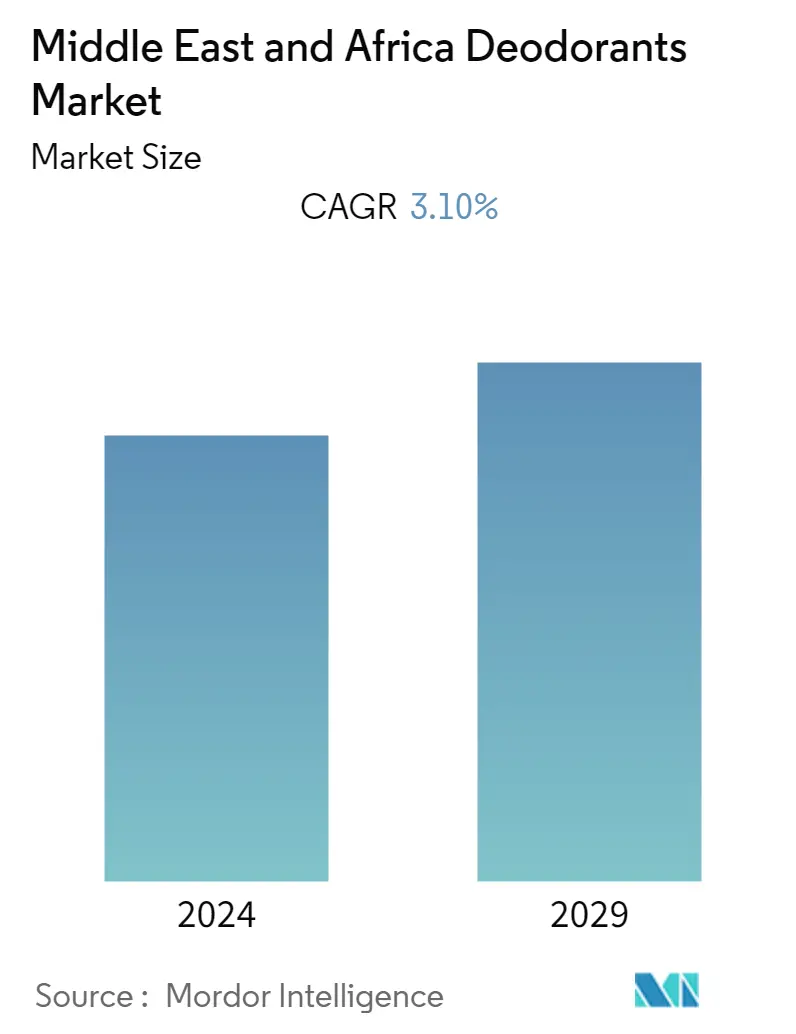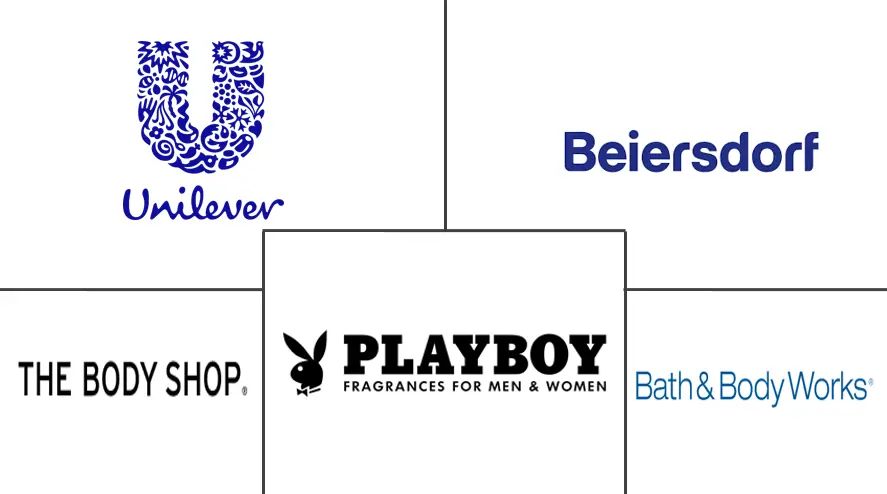Market Size of Middle East & Africa Deodorants Industry

| Study Period | 2019 - 2029 |
| Base Year For Estimation | 2023 |
| Forecast Data Period | 2024 - 2029 |
| Historical Data Period | 2019 - 2022 |
| CAGR | 3.10 % |
| Market Concentration | Low |
Major Players
*Disclaimer: Major Players sorted in no particular order |
MEA Deodorants Market Analysis
The Middle East & Africa deodorants market is projected to grow at a CAGR of 3.1% over the forecast period, 2020 - 2025.
- The market is majorly driven by the increasing awareness about health and hygiene among the people in the country, along with innovation in new formats and fragrances in the market. In addition, rising demand for gender-specific products is expected to enhance market prospects. Furthermore, marketing and promotion activities through media have further accelerated the brand growth by increasing consumer awareness regarding the content of the product, especially the natural and organic deodorants as consumers are now seeking deodorants containing natural ingredients due to rising adverse health effect of artificial ingredients in deodorants.
- However, the growing awareness towards the use of chemical substances in such deodorants, which is considered as a harmful substance for the skin, is expected to hinder the growth of the deodorants market.
MEA Deodorants Industry Segmentation
The Middle East & Africa deodorants market is segmented by product type and distribution channel. By product type, the market is segmented into sprays, roll-on, sticks, and others; and by distribution channel as supermarket/hypermarkets, convenience stores, specialty stores, drug stores/pharmacies, online retail stores, and others. Also, the study provides an analysis of the deodorants market in the emerging and established markets across the Middle East & Africa region, including South Africa, Saudi Arabia, and the Rest of the Middle East & Africa.
| By Product Type | |
| Sprays | |
| Roll-On | |
| Stick | |
| Others |
| By Distribution Channel | |
| Hypermarkets/Supermarkets | |
| Convenience Stores | |
| Specialist Retail Stores | |
| Drug Stores/Pharmacies | |
| Online Retail Stores | |
| Others |
| By Geography | |
| South Africa | |
| Saudi Arabia | |
| Rest of Middle East & Africa |
Middle East & Africa Deodorants Market Size Summary
The Middle East and Africa deodorants market is experiencing growth driven by heightened awareness of health and hygiene, alongside innovations in product formats and fragrances. The demand for gender-specific products is also contributing to the market's expansion. Marketing efforts, particularly through media, have played a significant role in increasing consumer awareness, especially regarding natural and organic deodorants. This shift is largely due to concerns over the adverse health effects of artificial ingredients. However, the market faces challenges from growing awareness about the potential harm of chemical substances in deodorants, which could impede growth.
Deodorant sticks are among the most popular formats, favored for their solid form that avoids a wet sensation and offers better control, reducing product wastage. These sticks are particularly appealing to consumers with sensitive skin due to their creamy texture. South Africa holds a substantial share of the market, with rapid growth attributed to westernization among the youth and the affordability of deodorants compared to traditional fragrances. The market is competitive and fragmented, with numerous regional and domestic players. Companies are focusing on mergers, expansions, acquisitions, and partnerships, along with new product development, to enhance their market presence. Key players include Unilever, Beiersdorf, The Body Shop South International Plc, and others, with recent product launches like Epic's new range in the UAE highlighting ongoing innovation.
Middle East & Africa Deodorants Market Size - Table of Contents
-
1. MARKET DYNAMICS
-
1.1 Market Drivers
-
1.2 Market Restraints
-
1.3 Porter's Five Forces Analysis
-
1.3.1 Threat of New Entrants
-
1.3.2 Bargaining Power of Buyers/Consumers
-
1.3.3 Bargaining Power of Suppliers
-
1.3.4 Threat of Substitute Products
-
1.3.5 Intensity of Competitive Rivalry
-
-
-
2. MARKET SEGMENTATION
-
2.1 By Product Type
-
2.1.1 Sprays
-
2.1.2 Roll-On
-
2.1.3 Stick
-
2.1.4 Others
-
-
2.2 By Distribution Channel
-
2.2.1 Hypermarkets/Supermarkets
-
2.2.2 Convenience Stores
-
2.2.3 Specialist Retail Stores
-
2.2.4 Drug Stores/Pharmacies
-
2.2.5 Online Retail Stores
-
2.2.6 Others
-
-
2.3 By Geography
-
2.3.1 South Africa
-
2.3.2 Saudi Arabia
-
2.3.3 Rest of Middle East & Africa
-
-
Middle East & Africa Deodorants Market Size FAQs
What is the current Middle East & Africa Deodorants Market size?
The Middle East & Africa Deodorants Market is projected to register a CAGR of 3.10% during the forecast period (2024-2029)
Who are the key players in Middle East & Africa Deodorants Market?
Unilever, The Body Shop South International Plc, Bath & Body Works Direct, Inc., SA Designer Parfums Ltd, Church & Dwight Co., Inc. and Beiersdorf AG are the major companies operating in the Middle East & Africa Deodorants Market.

